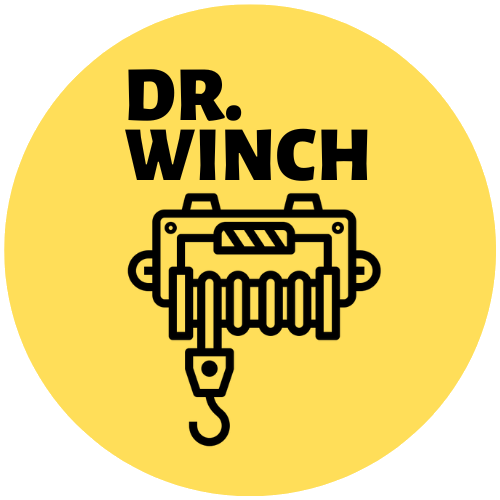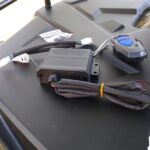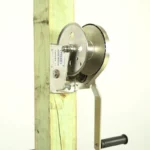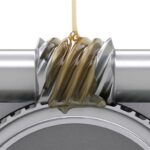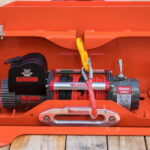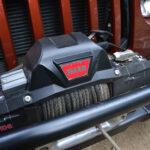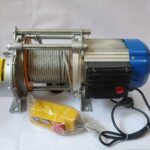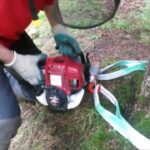A chainsaw winch is a winch connected to a chainsaw. The Winch draws power from the Chainsaw machine’s motor, giving the impression that the two are interdependent.
However, when the Winch and the Chainsaw work together, a little chainsaw engine transforms into a powerful pulling machine that can execute rescue missions in addition to the typical functions like cutting and hauling.
Furthermore, the equipment’s mobility and the Winch will function as long as there is gasoline in the Chainsaw tank, making the complete setup self-contained, which are its key advantages.
How do you decide which Chainsaw is best for your Winch?
You must make sure there is enough power to hoist loads—not too much nor too little—because the Chainsaw’s engine generates the appropriate force or pull for the Winch.
Chainsaws with 7 HP or more have a strong torque and must be handled carefully when winching to avoid getting more than you intended. Similarly, chainsaws with less power would only overheat faster and burn out.
Electric chainsaws may be connected to winches hauling lower weights, but a gas chainsaw is the best option if you use your winches for heavy tasks and need a flexible power supply.
Consider the Weight to HP ratio/rate when buying a Chainsaw for your Winch while pulling weights in a straight line. Keep in mind that if you include a Snatch Block, the load you pull may increase by double.
How to prepare to make a chainsaw winch?
Remove the bar (obviously) and use your chainsaw powerhead to raise large objects with the help of the chainsaw winch, a useful multi-purpose winching equipment.
It has a long cable that has been wrapped repeatedly around a drum. Its sturdy yet lightweight design makes transferring any car’s trunk simple. While some winches are linked to the frame, some are designed to secure the vehicle’s front bumper.
If you want to increase the safety of the item, you may affix the chainsaw winch to the bed of your vehicle with the proper adapters. Some adapters attach the device to a rock, while others attach to the trailer hitch.
While being operated, the Winch cannot move thanks to the adapters. Therefore, adapters ensure the safety of the saw and anything else you’re hauling, as well as your safety.
A few preparations you need to complete before starting our how to build a chainsaw winch tutorial.
1. Gather The Parts You Need
One of the two locations will have the components your chainsaw winch requires. You can get further information from a steel supplier or a nearby scrap dealer. You may get it from the scrap yard for cheaper money.
A neighboring scrap dealer has these pieces for sale. Again, you will save money compared to purchasing them brand-new from a steel source. Make sure your car has a shaft, pulley, and other parts. If you prefer to tinker, you may also find these parts in old automobiles and appliances.
- A chainsaw
- Pulley
- Shaft
- Flat iron
- Chanel
- Angles
2. Separate The Chainsaw Blade from The Engine
The winch and chainsaw blade cannot both be powered by the same engine at the same time. Therefore, you must first disengage the chainsaw blade from the motor.
Follow the directions in Chainsaw’s instruction manual to remove the saw. Nobody retains manuals forever. Online instructions are available to you if you don’t have the handbook. Use Chainsaw’s manual if you have one for your brand and model. The designs could change from time to time.
The process should be the same if you need to change the saw. Store your saw properly to avoid corrosion and other damage. You could require it in the future to finish another chainsaw job.
3. Examine The Engine of The Chainsaw
If you’ve owned your Chainsaw for a while, hopefully, you’ve taken care of the engine maintenance as needed. How well you maintain your chainsaw engine will determine how well your winch functions. Your attempts to construct a winch will be ineffective if your Chainsaw is broken.
The clutch and throttle are two essential elements for your Winch to function properly. Both of them need to be in good operating condition.
Steps to make a chainsaw winch
Step 1: Remove the Chainsaw
The Chainsaw and engine must be separated, so do that first. The creating procedure won’t begin unless you do this. This is so that the saw and the Winch can’t be in the same engine.
You can read the instructions if you need to know how to dismantle anything. This manual can also be used to establish a connection. Once you’ve detached the saw, put it away in a secure location. This saw comes in handy for felling trees.
Step 2: Check your Chainsaw's engine
A chainsaw engine that is not efficient cannot function as a winch. You should perform the preliminary work as well as the engine inspection. Verify that the clutch and throttle are in working order, among other engine components. You should avoid touching the engine if any components appear to be rusted. A conventional winch cannot be constructed without a good clutch and throttle. You will occasionally need to replace the oil. A well-maintained engine provides excellent winching performance.
Step 3: Make these changes
For the most part, you already have a chainsaw, engine, and duct tape. These components by themselves, though, are no longer adequate. A DIY winch also requires additional components. For instance, cables and scrap metal may be required.
A steel cable that is dependable, powerful, and flexible must be used to construct a capstan. You may also think about utilizing aluminum. Steel cables are rust-resistant and strong enough not to break when used for heavy lifting.
Don’t forget to purchase the components Winch requires, like the channel, flat iron, pulley, shaft, angle, and more. You can get the steel from any neighborhood store or steel supply firm. Older wagons can also be used to get these parts, but newer ones will continue to serve you better.
Step 4: Set up the Winch
All components are prepared so you can put the chainsaw winch together immediately. Attach the steel cable. A cable is wound around a capstan to create a capstan winch. Next, cut the flat iron, the channel, and the angles to form the Winch’s foundation.
Step 5: The Winch should be connected
After removing the saw, all chainsaw components must also be taken out. After taking out the saw, remove the big washer from the joiner. To attach the Winch, you should also add a little washer. The sprocket may now be fitted into the Winch’s matching hole. On the front side are two holes where the bar studs may be inserted.
As you flip to the lower side, more slots and adjustable planks are visible. However, simply fastening them creates a winch.
Step 6: Enroll the Cable
The following step is to enroll in the cable. Always strive to maintain its straightness since a coiled or wrinkled wire will not look attractive. Drop now through the opening. On the drum, it needs to be pushed towards the opposite side.
Duct tape may be applied in this situation to stop the cable from rolling about. Sometimes it helps to retain the cable in place since the tape prevents it from automatically spooling.
Step 7: Finishing Touch
Now that you have a new DIY winch, it’s time to start the engine. To lock the Winch, you must unroll the cable. Keep in mind that the Chainsaw is not required to be fastened to the Winch. Verify the load’s stability. Do not overload the Winch with weights that are heavier than 5000 pounds.
How does a chainsaw winch work?
A chainsaw serves as the power source for a chainsaw winch, which is a motorized winch. Working of a chainsaw winch is very similar to how a capstan winch.The chain and bar are taken off before the Winch is added. A high torque powers the Winch, and low RPM rotation is created from the Chainsaw’s high rotational speed. Most chainsaw winches have a brake and a clutch and can winch in both directions.
Typically, the chainsaw winch is attached to the powerhead’s sprocket after removing the chain and bar. The connection enables the input shaft of the Winch to be powered by the Chainsaw’s output shaft. The cable spool rotates while the oil-filled gearbox of the Winch converts high revolutions per minute to low revolutions per minute, wrapping the rope around a drum and pulling the item in.
In general, chainsaw winches are entirely portable, simple, and light in design. They are useful and adaptable because they can be used with chainsaw powerheads, enabling loggers and others who use chainsaws to use winches to move logs, carry large objects, or pull big objects, such as a heavy animal or a vehicle.
Limitations of Chainsaw Winch
Winches can only pull loads up very small inclines. A hoist is required to lift objects over slopes steeper than 45 degrees. A winch won’t operate.
The amount of weight that your Winch can pull has a maximum. But the extent to which your Chainsaw’s engine can cut through that limit varies. So think about your Chainsaw’s horsepower before you hook your Winch to any weight. The amount of weight your Winch can draw will also depend on the type of towline you employ.
Think about how much force is needed to move these big weights.
- 2,000 lb. – 2,500 lb. works best with a 3HP Chainsaw
- 3,000 lb. – 3,500 lb. works best with a 5-6HP Chainsaw
- 4,000 lb. works best with a 7HP Chainsaw
Summary
The chainsaw winch’s mobility is incredible! You won’t need a truck to utilize this Winch; you may use just your hands! As a result, you can winch in more confined spaces and eventually increase your level of adaptability. The chainsaw winch’s mobility is incredible! You won’t need a truck to utilize this Winch; you may use just your hands! As a result, you can use the chainsaw winch in more confined spaces and eventually increase your level of adaptability.
More on Winch
